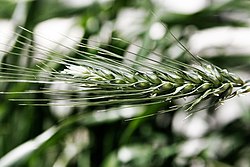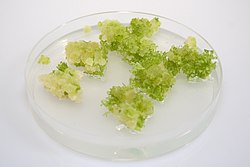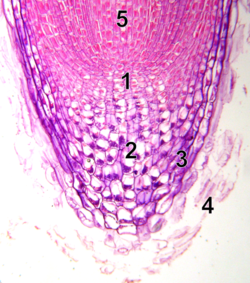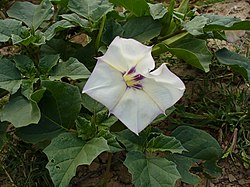A
- ab-
- Prefix meaning "position away from". [1]
- abaxial
- Surface of an organ facing away from the organ's axis, e.g. the lower surface of a lateral organ such as a leaf or petal. [2] Contrast adaxial .
- abort
- To abandon development of a structure or organ. [3]
- abscission
- Natural shedding of an organ that is mature or aged, as of a ripe fruit or an old leaf. [4]
- abscission zone
- Specialized layer of tissue that allows an organ to be shed by abscission when it is ripe or senescent. Such tissue is commonly formed, for example, at the base of a petiole or pedicel.
- acaulescent
- Having no apparent stem, or at least none visible above the ground surface. [2] Examples include some species of Oxalis , [5] Nolina , [6] and Yucca . [7] Antonym: caulescent (possessing stem).
- accrescent
- Increasing in size with age, such as a calyx that continues to grow after the corolla has fallen, [2] e.g. in Physalis peruviana .
- accumbent
- Lying against another part of the plant; when applied to a cotyledon, it means that an edge of the cotyledon lies along the folded radicle in the seed. [8]
- -aceae
- Suffix added to the word stem of a generic name to form the name of a taxonomic family; [9] for example, Rosaceae is the rose family, of which the type genus is Rosa . [10]
- achene
- Dry, one-seeded indehiscent fruit [11] in which the true fruit is not the so-called "berry", but the achenes, which are the so-called "seeds" on the infructescence, e.g. in the genus Fragaria .
- acicular
- Slender or needle-shaped. [11] See also Leaf shape .
- acropetal
- Moving from roots to leaves, e.g. of molecular signals in plants.
- acrophyll
- Regular leaves of a mature plant, produced above the base, as opposed to bathyphyll.
- acrostichoid
- (describing a type of sorus) Covering the entire abaxial surface of a frond, usually densely so, as in Elaphoglossum and Acrostichum .
- actino-
- Prefix that indicates a radial pattern, form, or morphology.
- actinodromous
- (of leaf venation) Palmate or radially arranged venation with three or more primary veins arising at or near the base of the leaf and reaching the margin in most species, but not all.
- actinomorphic
- Regular or radially symmetrical; [12] may be bisected into similar halves in at least two planes. Applies e.g. to steles and flowers in which the perianth segments within each whorl are alike in size and shape. Compare regular . Contrast asymmetrical , irregular , and zygomorphic .
- aculeate
- Armed with prickles, [13] e.g. the stem of a rose.
- acumen
- A long, tapering point, especially the apex of an acuminate leaf.
- acuminate
- Tapering gradually to a point, with concave sides approaching the point. [13] Contrast acute and mucronate . See also Leaf shape .
- acute
- 1. Sharply pointed, but not drawn out, with straight sides approaching the point. [13] Contrast acuminate . See also Leaf shape .
- 2. Converging at an angle of less than 90°. Contrast obtuse .
- ad-
- Prefix meaning "near or toward"; also meaning "added to". [13]
- adaxial
- Surface of an organ facing toward the organ's axis, [13] e.g. the upper surface of a lateral organ such as a leaf or petal. Contrast abaxial .
- adelphia
A bundle or structure of stamens forming one unit in an adelphous flower; for example, the stamen tube around the pistil of Hibiscus .
- adelphous
- Having organs, particularly filaments such as stamens, connected into one or more adelphiae, whether in the form of bunches or tubes, such as is commonly seen in families such as Malvaceae. Usage of the term is not consistent; some authors include closely bunched filaments, while others include only adelphiae in which filaments are connected minimally at their bases. See, for example, Sims: "...the filaments are so closely pressed that they have the appearance of being monadelphous...". [14] Compare derived terms such as monadelphous , having stamens growing in a single bunch or tube, for example in Hibiscus , and diadelphous , growing in two bunches.
- adherent
- Slightly united to an organ of another kind, [13] usually to a part of another whorl, e.g. a sepal connected to a petal. Contrast adnate .
- adnate
- Grown from or closely fused to an organ of a different kind, [13] especially along a margin, e.g. a stamen fused to a petal. Adnate anthers have their halves attached to the filament through most of their length. Contrast connate .
- adpressed
- See appressed
- adventitious
- Produced in an unpredictable or unusual position, [13] e.g. an adventitious bud produced from a stem rather than from the more typical axil of a leaf. Adventitious roots may develop from nodes of prostrate stems of some plant species, or from the hypocotyl rather than from the radicle of a germinating monocotyledon.
- adventive
- Introduced accidentally [13] (usually referring to a weed).
- aerial
- Of the air; growing or borne above the surface of the ground or water. [15]
- aestivation
- Arrangement of sepals and petals or their lobes in an unexpanded flower bud. Contrast vernation .
- aff. (affinis)
- With affinity to others, akin to; often used for a provisionally recognized but unnamed taxon considered close to that name, perhaps a hybrid or extreme variant.
- aggregate fruit
- Cluster of fruits formed from the free carpels of a single flower, e.g. a blackberry. Compare multiple fruit .
- agochoric
- Plants that are spread through accidental transport.
- agricultural weed
- See weed .
- agriophyte
- Plant species that have invaded native vegetation and could survive there without human intervention. They are established there in natural habitats, remaining part of natural vegetation even after human influence has ceased, and are independent of humans in their continued existence. [16]
- agrophic
- Comb-like series of veins forking from a single side of a primary or secondary vein.
- agrostology
- The scientific study of grasses, in the strictest sense only those species which are members of the family Poaceae. Broader usages sometimes also include grass-like or graminoid species from the families Cyperaceae, Juncaceae, and Typhaceae.
- alate
- Having a wing or wings.
- albumen
- Older name for the endosperm of flowering plants. Except for being a storage tissue for nutrients, it is not like the albumen (egg white) of animal embryos.
- albuminous
- (of seeds) Containing endosperm.
- -ales
- Suffix added to the stem of a generic name or descriptive name to form the name of a taxonomic order.
- alien
- Any plant introduced to an area outside its natural range. Often used interchangeably or in combination with foreign, exotic , non-native , and non-indigenous .
- alkaloid
- Any of a loosely defined class of organic compounds found in the tissues of many species of plants. Alkaloid molecules have one or more alkaline-reacting nitrogen atoms in their carbon structures. Many alkaloids are commercially important as drugs or poisons, e.g. caffeine, morphine, quinine, and strychnine, each of which occurs naturally in certain plants.
- allelopathy
- The secretion by a plant of biochemicals which influence the growth and reproduction of nearby plants.
- allopatric
- Having geographically separate, non-overlapping ranges of distribution. [17] Contrast sympatric .
- alternate
- 1. (adj.) (of leaves or flowers) Borne singly at different levels along a stem, including spiralled parts. Contrast opposite .
- 2. (prep.) Occurring between something else, e.g. stamens alternating with petals.
- alternipetalous
- A configuration where parts of the flower, e.g. stamens, alternate in position with the petals. [18]
- ament
- A synonym of catkin .
- amphitropous
- (of an ovule) Bent so that both ends are near each other. Contrast anatropous , campylotropous , and orthotropous .
- amplexicaul
- With the base dilated and clasping the stem, usually of leaves.
- amylum star
- a vegetative propagative body filled with starch (amylum) and located around the lower nodes of certain stoneworts.
- anastomose
- Branching and then rejoining, as with leaf venation.
- anastomosis
- A connection or fusion of two or more veins that are normally diverging or branching, thereby forming a network.
- anatropous
- (of an ovule) Inverted so that the micropyle faces the placenta (this is the most common ovule orientation in flowering plants). Contrast amphitropous , campylotropous , and orthotropous .
- ancipital
- Flat, with two edges (versus round). [19]
- androdioecious
- Having bisexual flowers and male flowers on separate individuals. Contrast andromonoecious , polygamodioecious , polygamomonoecious , and polygamous .
- androecium
- A collective name for the male reproductive parts of a flower; the stamens of a flower considered collectively. Contrast gynoecium . Abbreviated A; e.g. A 3+3 indicates six stamens in two whorls.
- androgynophore
- A stalk bearing both the androecium and gynoecium of a flower above the level of insertion of the perianth.
- androgynous
- Having male and female flowers in the same inflorescence.
- androphore
- The stalk or column supporting the stamens in certain flowers.
- andromonoecious
- Having bisexual flowers and male flowers on the same individual plant. Contrast androdioecious , gynomonoecious , polygamodioecious , polygamomonoecious , and polygamous .
- anemophilous
- Adapted to pollination by wind.
- anemophily
- Adaptation to pollination by wind.
- angiosperm
- A flowering plant; a plant with developing seeds enclosed in an ovary.
- anisomery
- The condition of having a floral whorl with a different (usually smaller) number of parts from the other floral whorls.
- anisotomic
- Branching, with branches having unequal diameters, such as a trunk and its branch. Contrast isotomic .
- annual
- A plant that completes its life cycle (i.e. germinates, reproduces, and dies) within a single year or growing season.
- annulus
- 1. A ring-like structure; in the form of a ring. Pappus bristles are sometimes attached to a ring called an annulus or disk at the top of the achene beak. In some pollen grains, the exine around the apertures is either thicker or thinner. In pores, this border is termed an annulus. Certain flowers have ring-like constrictions at the mouth of the flower, e.g. in Huernia and Aristolochia .
- 2. A ring of specialized cells on the sporangium.
- anterior
- Positioned in front of, toward the apex. Compare distal .
- anthemoid
- In the Compositae, a style with a brush-like tuft of sweeping hairs at the tip of each style branch.
- anther
- The pollen-bearing part of a stamen.
- antheridium
- in bryophytes, a specialized gametophytic organ that produces the male gametes.
- antheridiophore
- In liverworts of the order Marchantiales, a male gametophore, a specialized, stalked structure that bears the antheridia.
- antherode
- A sterile anther of a staminode.
- anthesis
- 1. (of a flower) The period during which pollen is presented and/or the stigma is receptive.
- 2. (of a flowering plant) The period during which flowers in anthesis are present. Not defined for some cases, such as when pollen is released in the bud.
- anthocarp
- A type of fruit in which some part of the flower persists attached to the pericarp, e.g. in Nyctaginaceae.
- anthophore
- A stalk-like structure, internode located between the calyx and the other parts of the flower.
- anticlinal
- Pointing up, away from, or perpendicular to a surface. Contrast periclinal .
- antrorse
- Directed forward or upward, e.g. of hairs on a stem. Contrast retrorse .
- apetalous
- Lacking petals.
- apex
The tip of a structure, e.g. a leaf, shoot, stem or trunk of a tree.
- aphananthous
- (of flowers) Inconspicuous or unshowy, as opposed to phaneranthous or showy.
- aphlebia
Imperfect or irregular leaf endings commonly found on ferns and fossils of ferns from the Carboniferous Period.
- aphyllous
- Leafless; having no leaves. [20]
- apical
- Adjectival form of apex.
- apiculate
- especially of leaves, ending in a short triangular point. See also Leaf shape .
- apiphily
- A form of pollination whereby pollen is distributed by honey bees.
- apo-
- A prefix meaning "away from, separate, without".
- apocarpous
- (of a gynoecium) Consisting of one or more carpels which are free from one another (or almost so), e.g. in members of the Ranunculaceae and Dilleniaceae.
- apomixis
A type of asexual reproduction whereby viable seeds or spores are produced asexually, without fertilization, such that the genetic material they contain is a clone of the parent's genetic material. A plant produced in this way is called an apomict.
- apomorphy
- In cladistics, a "different form" from the form of an ancestor (i.e., an innovation) of use in determining membership in a clade.
- apopetalous
- Having separate petals, not fused (sympetalous).
- apophyllous
- Perianth or other segments free, not united. Compare symphyllous , gamophyllous , and polyphyllous .
- apophysis
- 1. The external part of a cone scale.
- 2. An outgrowth of an organ or an enlargement of a stem.
- appendage
- A secondary part attached to a main structure; an external growth that seldom has any obvious function, hence appendiculate.
- appendiculate
- Having the nature of or bearing appendages.
- appressed
- Pressed closely but not fused, e.g. leaves against a stem.
- aquatic plant
- A plant whose natural habitat is water, living in or on water for all or a substantial part of its lifespan; generally restricted to fresh or inland waters.
- arachnoid
- Cobwebby, from being covered with fine white hairs.
- arborescent
- Tree-like in growth or general appearance.
- arboretum
A taxonomically arranged collection of trees.
- archaeophyte
- A non-native plant that has nonetheless been present in a particular geographic area for some time. Contrast neophyte .
- archegonium
- A multicellular haploid structure or organ of the gametophyte phase of certain plants, producing and containing the ovum or female gamete. The corresponding male organ is called the antheridium.
- archegoniophore
- In liverworts of the order Marchantiales, a female gametophore: a specialized, stalked structure that bears the archegonia and the sporophytes.
- arctotoid
- In the Compositae, a style with a ring of sweeping hairs borne on the shaft of the style proximal to the style branches.
- areolate
- Having or being composed of areoles, as an areolate crustose lichen.
- areole
- 1. A space between the threads of a net, e.g. that part of a leaf surface defined by each of the elements of a vein network; as with cacti, the area between the veinlets of a leaf.
- 2. A structure on the stem node of a cactus, morphologically a specialised branch; the region of a cactus upon which spines, glochids, and flowers are borne.
- aril
- A membranous or fleshy appendage formed by expansion of the funicle which partly or wholly covers a seed, e.g. the fleshy outer layer of lychee fruit, or that found in members of the Sapindaceae.
- aristate
- With a stiff, bristle-like awn or tip. See also Leaf shape .
- article
- A segment of a jointed stem or of a fruit with constrictions between the seeds; an organ part that separates easily from the rest of the organ at a joint or articulation.
- articulate
- Jointed; separating freely, leaving a clean scar; e.g. the fronds of certain ferns where they join the rhizome.
- ascending
- 1. (of a stem) Spreading horizontally, then directed upward; an ascending stem is more or less prostrate near its base, then erect.
- 2. (of an ovule) Attached somewhat above the base.
- ascidiate
- Shaped like a pitcher, as with the leaves of pitcher plants, e.g. species of Nepenthes and Sarracenia . [21]
- asexual reproduction
- Reproduction that does not involve gametes. Often used interchangeably with vegetative reproduction.
- asperulous
- Having a rough, sandpapery texture; e.g. some leaf surfaces.
- asymmetrical
- Irregular or unequal; lacking any plane of symmetry; e.g. flowers of Canna .
- attenuate
- Narrowing gradually. See also Leaf shape .
- auricle
- An ear-shaped lobe, particularly a small, roundish, lateral appendage of a leaf or leaf-like organ.
- auriculate
- Attached at the base with ear-shaped appendages (auricles). See also Leaf shape .
- autogamous
- Self-pollinating, self-fertilizing – in flowering plants
- awn
- 1. Any long, bristle-like appendage.
- 2. In the Poaceae, an appendage terminating or on the back of glumes or lemmas of some grass spikelets.
- 3. In the Geraniaceae, the part of the style that remains attached to the carpel that separates from the carpophore (column).
- 4. A generally straight, stiff pappus element, varying from stiffly bristle-like to hard and needle-like. In Strophanthus , the awn is the beak of the seed, stipe of the coma hairs.
- axil
- The upper angle between one part of a plant and another, e.g. the stem and a leaf.
- axile
- On an axis; of a placenta, on the central axis of the ovary.
- axillary
- Borne in or arising from the axil, usually referring to the axil of a leaf.
- axis
- The main stem of a whole plant or inflorescence; also, the line along which this stem extends.
- Hairs on the leaves of Meniocus linifolius (formerly Alyssum linifolium) are stellate and appressed to the leaf surface.
- Infructescence of wild rye, showing prominent awns
- Anatomy of an awn and bristles on a species of the Australian grass Rytidosperma longifolium
- Axillary buds in leaf










































































































































































































































































































